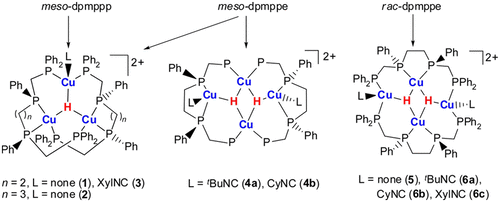当前位置:
X-MOL 学术
›
Inorg. Chem.
›
论文详情
Our official English website, www.x-mol.net, welcomes your
feedback! (Note: you will need to create a separate account there.)
Tri- and Tetranuclear Copper Hydride Complexes Supported by Tetradentate Phosphine Ligands
Inorganic Chemistry ( IF 4.3 ) Pub Date : 2018-08-21 00:00:00 , DOI: 10.1021/acs.inorgchem.8b01628 Takayuki Nakajima 1 , Yoshia Kamiryo 1 , Kanae Hachiken 1 , Kanako Nakamae 1 , Yasuyuki Ura 1 , Tomoaki Tanase 1
Inorganic Chemistry ( IF 4.3 ) Pub Date : 2018-08-21 00:00:00 , DOI: 10.1021/acs.inorgchem.8b01628 Takayuki Nakajima 1 , Yoshia Kamiryo 1 , Kanae Hachiken 1 , Kanako Nakamae 1 , Yasuyuki Ura 1 , Tomoaki Tanase 1
Affiliation

|
Three types of tetradentate phosphine ligands with different central methylene chains and configurations, meso- and rac-Ph2PCH2P(Ph)(CH2)nP(Ph)CH2PPh2 (n = 2, meso- and rac-dpmppe; n = 3, meso-dpmppp) were utilized to synthesize a new series of tri- and tetranuclear copper hydride complexes. Reactions of meso-dpmppe or meso-dpmppp with CuCl/NH4PF6 or [Cu(CH3CN)4]PF6 in the presence of NaBH4 afforded trinuclear copper hydride complexes, [Cu3(μ3-H)(meso-dpmppe)2](PF6)2 (1) and [Cu3(μ3-H)(meso-dpmppp)2](PF6)2 (2), while a similar reaction with rac-dpmppe resulted in the formation of a tetranuclear copper dihydride complex, [Cu4(μ3-H)2(rac-dpmppe)2](PF6)2 (5). Complexes 1 and 5 further reacted with RNC (R = tBu, Cy, Xyl) to give [Cu3(μ3-H)(meso-dpmppe)2(XylNC)](PF6)2 (3), [Cu4(μ3-H)2(meso-dpmppe)2(RNC)2](PF6)2 (R = tBu (4a), Cy (4b)) and [Cu4(μ3-H)2(rac-dpmppe)2(RNC)2](PF6)2 (R = tBu (6a), Cy (6b), Xyl (6c)), respectively. Complexes 1–6 were characterized by ESI-MS and 1H and 31P NMR spectroscopy and X-ray diffraction analyses, demonstrating that a hydride ligand is located at the center of triangular Cu3 plane of 1–3, while two μ3-hydride-capped Cu3 planes are fused to result in rhombic Cu4H2 structures in 4a,b, 5, and 6a–c. Complexes 1–6 in CD3CN solutions notably showed high thermal stability and no reactivity toward H2O and CO2. DFT calculations indicated an interesting correlation between the Wiberg bond indices (WBI) of Cu–H bonds and their natural atomic charge (NAC), where the isocyanide ligands had an appreciable influence on the Cu–H interactions.
中文翻译:

四齿膦配体支持的三核和四核氢化铜配合物
三种类型的四齿膦配位体的具有不同中心亚甲基链和配置,内消旋-和外消旋-Ph 2 PCH 2 P(PH)(CH 2)Ñ P(PH)CH 2 PPH 2(Ñ = 2,内消旋-和外消旋- dpmppe;n = 3,内消旋-dpmppp)用于合成一系列新的三核和四核氢化铜配合物。中观-dpmppe或中观-dpmppp与CuCl / NH 4 PF 6或[Cu(CH 3 CN)4] PF 6中的NaBH存在4,得到三核铜氢化物络合物,[铜3(μ 3 -H)(内消旋-dpmppe)2 ](PF 6)2(1)和[铜3(μ 3 -H)(内消旋-dpmppp)2 ](PF 6)2(2),而具有类似的反应外消旋-dpmppe导致了四核二氢化铜配合物,[在该Cu 4(μ 3 -H)2(外消旋-dpmppe)2](PF 6)2(5)。配合物1和5与RNC进一步反应(R =吨卜中,Cy,的Xyl),得到[铜3(μ 3 -H)(内消旋-dpmppe)2(XylNC)](PF 6)2(3),[铜4(μ 3 -H)2(内消旋-dpmppe)2(RNC)2 ](PF 6)2(R =吨BU(图4a)中,Cy(图4b))和[铜4(μ 3 -H)2(外消旋-dpmppe)2(RNC)2 ](PF 6)2(R =吨BU(图6a)中,Cy(图6b),的Xyl(6C)),分别。配合物1 - 6通过ESI-MS进行表征和1 H和31 P NMR光谱法和X射线衍射分析,表明氢化物配位体位于三角形的Cu的中心3的平面1 - 3,而2μ 3 -氢化物封端的Cu 3平面被融合,从而在4a,b,5和6a – c中形成菱形的Cu 4 H 2结构。配合物1 - 6在CD 3 CN溶液特别是显示出高的热稳定性和朝向H无反应性2 O和CO 2。DFT计算表明,Cu–H键的Wiberg键指数(WBI)与它们的自然原子电荷(NAC)之间存在有趣的相关性,其中异氰酸酯配体对Cu–H相互作用具有显着影响。
更新日期:2018-08-21
中文翻译:

四齿膦配体支持的三核和四核氢化铜配合物
三种类型的四齿膦配位体的具有不同中心亚甲基链和配置,内消旋-和外消旋-Ph 2 PCH 2 P(PH)(CH 2)Ñ P(PH)CH 2 PPH 2(Ñ = 2,内消旋-和外消旋- dpmppe;n = 3,内消旋-dpmppp)用于合成一系列新的三核和四核氢化铜配合物。中观-dpmppe或中观-dpmppp与CuCl / NH 4 PF 6或[Cu(CH 3 CN)4] PF 6中的NaBH存在4,得到三核铜氢化物络合物,[铜3(μ 3 -H)(内消旋-dpmppe)2 ](PF 6)2(1)和[铜3(μ 3 -H)(内消旋-dpmppp)2 ](PF 6)2(2),而具有类似的反应外消旋-dpmppe导致了四核二氢化铜配合物,[在该Cu 4(μ 3 -H)2(外消旋-dpmppe)2](PF 6)2(5)。配合物1和5与RNC进一步反应(R =吨卜中,Cy,的Xyl),得到[铜3(μ 3 -H)(内消旋-dpmppe)2(XylNC)](PF 6)2(3),[铜4(μ 3 -H)2(内消旋-dpmppe)2(RNC)2 ](PF 6)2(R =吨BU(图4a)中,Cy(图4b))和[铜4(μ 3 -H)2(外消旋-dpmppe)2(RNC)2 ](PF 6)2(R =吨BU(图6a)中,Cy(图6b),的Xyl(6C)),分别。配合物1 - 6通过ESI-MS进行表征和1 H和31 P NMR光谱法和X射线衍射分析,表明氢化物配位体位于三角形的Cu的中心3的平面1 - 3,而2μ 3 -氢化物封端的Cu 3平面被融合,从而在4a,b,5和6a – c中形成菱形的Cu 4 H 2结构。配合物1 - 6在CD 3 CN溶液特别是显示出高的热稳定性和朝向H无反应性2 O和CO 2。DFT计算表明,Cu–H键的Wiberg键指数(WBI)与它们的自然原子电荷(NAC)之间存在有趣的相关性,其中异氰酸酯配体对Cu–H相互作用具有显着影响。

































 京公网安备 11010802027423号
京公网安备 11010802027423号